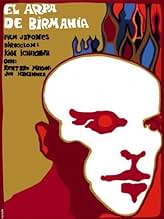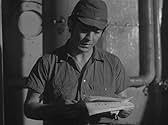Dans les derniers jours de la guerre, lorsqu'un soldat japonais animé par sa conscience ne parvient pas à convaincre ses compatriotes de se rendre devant une force écrasante, il adopte le st... Tout lireDans les derniers jours de la guerre, lorsqu'un soldat japonais animé par sa conscience ne parvient pas à convaincre ses compatriotes de se rendre devant une force écrasante, il adopte le style de vie d'un moine bouddhiste.Dans les derniers jours de la guerre, lorsqu'un soldat japonais animé par sa conscience ne parvient pas à convaincre ses compatriotes de se rendre devant une force écrasante, il adopte le style de vie d'un moine bouddhiste.
- Réalisation
- Scénario
- Casting principal
- Nommé pour 1 Oscar
- 4 victoires et 3 nominations au total
- Kobayashi
- (as Takeo Naito)
- Baba
- (as Akira Nishimura)
Avis à la une
In July, 1945, a Japanese platoon in Burma gets captured by the British army. One of the men - named Mizushima - has to go to the mountains to convince another Japanese platoon to surrender. But the latter platoon refuses to do so and all the members get killed in a shootout. As Mizushima walks back to his platoon, he comes across the bodies of more soldiers who perished in the war. Thus he sees his new mission in life: no longer can he be a soldier, but becomes a Buddhist monk, with the aim of healing all affected by the war.
I see Mizushima as representing what Japan as a society had to do following its defeat in WWII. Aside from the fact that the Land of the Rising Sun has had to be a pacifist country (the US forced it to have a constitution prohibiting military intervention), the bombing of Hiroshima made the Japanese people averse to militarism in general. Certainly this movie's anti-war stance makes it all the more relevant in this day and age. I recommend it.
The film takes its name from a Burmese harp acquired by Mizushima. He has become an expert harpist and plays while the soldiers sing beautiful chorales with a sound so lush it feels as if it is coming from the Mormon Tabernacle. While the depiction of the soldiers may be idealized, The Burmese Harp transcends its limitations to become a universal testament not only to the madness that prevailed in Burma, but to the unspeakable horror of all war. Ichikawa, in spite of the fact that film became a classic, loved the story so much that he filmed it again in 1985.
Le saviez-vous
- AnecdotesViewers familiar with Godzilla (1954), may recognize many of the cues present in The Burmese Harp's soundtrack, as composer Akira Ifukube adapted Godzilla's requiem theme into several pieces heard throughout the film.
- GaffesThe modern harp (with its pedal changes and its consequent ability to make changes of harmony, in particular)that is played throughout on the film's soundtrack does not match the much more basic instrument shown in the film.
- Citations
Captain Inouye: [Excerpt from Mizushima's letter, which Captain Inouye reads to his men as they sail back to Japan] As I climbed mountains and crossed streams, burying the bodies left in the grasses and streams, my heart was wracked with questions. Why must the world suffer such misery? Why must there be such inexplicable pain? As the days passed, I came to understand. I realized that, in the end, the answers were not for human beings to know, that our work is simply to ease the great suffering of the world. To have the courage to face suffering, senselessness and irrationality without fear, to find the strength to create peace by one's own example. I will undergo whatever training is necessary for this to become my unshakable conviction.
- ConnexionsFeatured in Ai no onimotsu (1955)
- Bandes originalesHanyuu no Yado
(Japanese Version of 'Home Sweet Home')
Meilleurs choix
- How long is The Burmese Harp?Alimenté par Alexa
Détails
Box-office
- Montant brut aux États-Unis et au Canada
- 20 015 $US
- Week-end de sortie aux États-Unis et au Canada
- 4 569 $US
- 20 oct. 2024
- Montant brut mondial
- 33 763 $US
- Durée
- 1h 56min(116 min)
- Couleur
- Mixage
- Rapport de forme
- 1.37 : 1




























